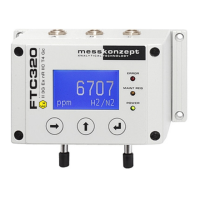Page 8 of 47
Chapter 2
Principle of Measurement
2.1 Determining Concentrations via Thermal Conductivity
Thermal Conductivity Detectors (TCD) have been used in the chemical industry since the 1920s as the
first process gas analyzers for the quantitative composition of gas mixtures. Every gas has a unique
heat conductivity that is governed by its molar mass and viscosity. The measurement is based on the
principle that the thermal conductivity of a gas mixture is dependent on the thermal conductivity of its
gas components and their fractional amounts in the mixture. Thus, the concentrations of different com-
ponents of a gas mixture can be calculated from thermal conductivity.
The main advantage of the TCD’s measurement principle compared with the widespread infrared anal-
ysis technique is that it is not limited to gases with a permanent dipole moment. It can identify noble
gases (He, Ar, Ne, etc.) as well as homonuclear gases such as H
2
and N
2
. Furthermore, it is robust
and cost effective.
The principle of thermal conductivity measurement works best if the analyzed gas components’ thermal
conductivity varies greatly. For TC measurement-based analysis, one of the following conditions must
be met:
• The mixture contains only two different gases (binary mixture), e.g., CO
2
in N
2
or H
2
in N
2
• The thermal conductivity of two or more components is similar but different than that of the mea-
suring gas, e.g., measuring H
2
or He in a mixture of O
2
and N
2
(quasi binary mixture)
• The mixture contains more than two gases and the volumetric fractions of all but two components
(or component groups) are constant over time
• The mixture contains more than two gases, of which all but two components’ concentrations
can be determined through other measurement principles (as employed in the FTC400 through
cross-sensitivity compensation of IR- and TC-sensor information).
The thermal conductivity of gases rises with temperature and the slope of the increase
with temperature is different for different gases. Upon request, it can be checked whether
the temperature of heat sink and/or source should be changed in order to improve the
accuracy or to avoid cross-sensitivity effects.
Cross-sensitivity is the sensitivity of the measurement on other gases than the measured
component. Perturbation-sensitivity means the sensitivity of the measurement to other
influences than the gas-composition, e.g., the gas pressure.
File name:
FTC320 Operating Manual_1.09KD201009MPO5V04.pdf

